As I stated in my last post, I realized that Lily had shown me several signs of her stomatitis before I understood she had a problem. I hope that by sharing them here that someone else will recognize the signs of stomatitis sooner than I did. Looking back, I realized that Lily had told me many times that she was in pain.
Screaming in Pain
The very first time I recall Lily expressing her pain was when I was folding laundry. The clothes were strewn across my couch, and Lily was lying on top of them. I folded the clothes, one by one, and eventually there was nothing left but what was underneath Lily.
I grabbed onto a sock and gently pulled it out from under Lily. When I did this, Lily gave a horrible scream, then jumped down and ran away. I followed her and found her hiding behind a book shelf. I was completely baffled about why Lily screamed, and was worried that I had someone hurt her by pulling out the sock, though I couldn’t imagine how.
It took me a while to coax her out to me, and when I did I checked the bones in her legs, and her paws. I no longer remember what I thought might have happened to her, but it never occurred to me to look in her mouth (she wasn’t yet drooling, and I hadn’t yet noticed any bad breath). There was no reason for me to check her mouth, yet if I had, I might have noticed how red and swollen her gums where.
Now, I understand what happened. When I pulled the sock out, either my hand or the sock brushed up against Lily’s mouth, causing her intense pain. That was the reason why she screamed, then ran and hid.
This wasn’t the only time I heard Lily scream in pain. There was another time that I happened to catch on video. It wasn’t until about a year after taking the video, when I was looking for video of her for this site, that I understood what I was looking at. If you watch the following video, you will see Lily playing “Bed Mice” as I made the bed. She gave a small yelp of pain, which I mistook for something else. You can hear me comment on it in the video below.
Drooling
Lily drooled long before I realized she was drooling. She left many drool spots around my house, but I didn’t connect the spots with drooling, or with Lily being in pain.
Here is an example of a drool spot, which was on my bed where Lily liked to sleep. Notice that the drool spots are red. That is because there was blood mixed with her saliva. The blood was from the inflamed tissue in Lily’s mouth.
Before I knew Lily had stomatitis, I didn’t actually see her drool. I only saw the spots she left behind, such as the ones seen in the above picture.
Matted Fur
Lily stopped grooming herself because it hurt her mouth too much to lick her fur. But I didn’t realize she had stopped. What I did notice was that she started to get a lot of matted fur. Lily’s fur is medium length, and is very silky. It easily mats up, and it got so bad that our vet shaved the matted fur each time I took her to the vet.
I later understood that Lily’s matted fur was also caused by her drooling. She would sleep with her tail tucked up around her face, and then drool from her mouth would collect on her tail fur. Her tail happens to have the longest hairs on her body. Because she wasn’t grooming, the drool dried, then the matting continued to get worse and worse.
If I had realized that matted fur was a symptom of something being wrong, I would have known to take her to the vet. The same is true for all of the other symptoms that I missed. Had I just known what was going on, I would have saved Lily from a lot of pain and suffering.
Cats are incredibly good at hiding their pain. Often we, as cat owners, need to be detectives and decipher the subtle (or not so subtle) clues that they leave us. If your cat starts to act in any way out of character, a trip to the vet may be in order, to rule out any major problems, such as stomatitis.
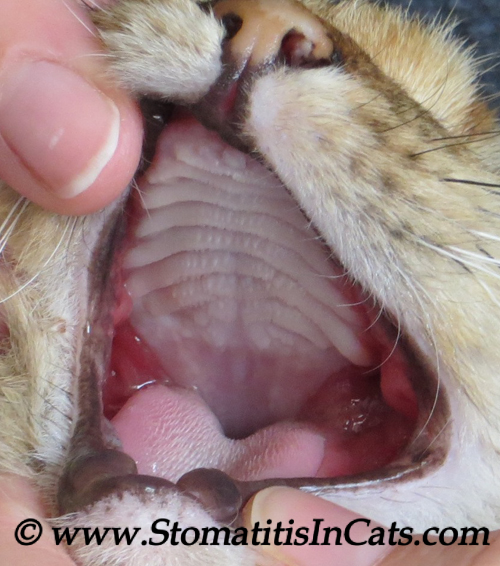
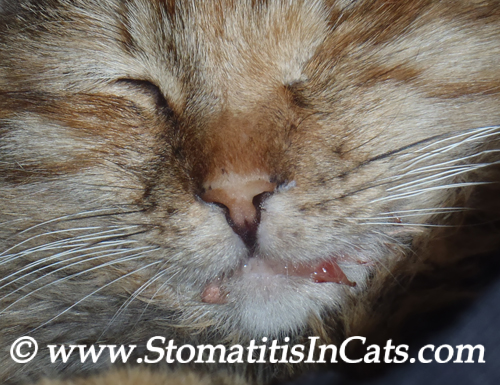
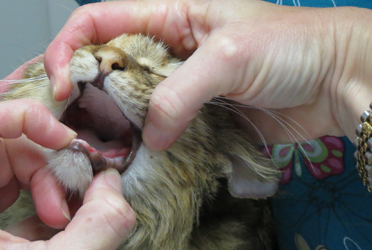
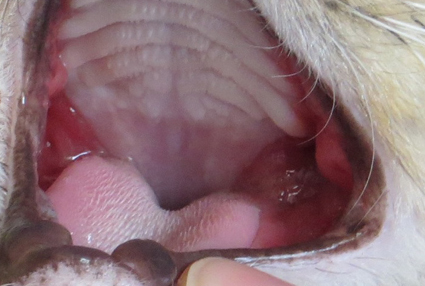
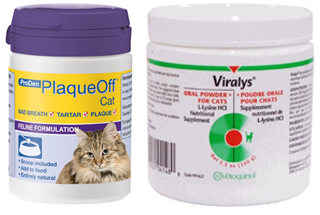
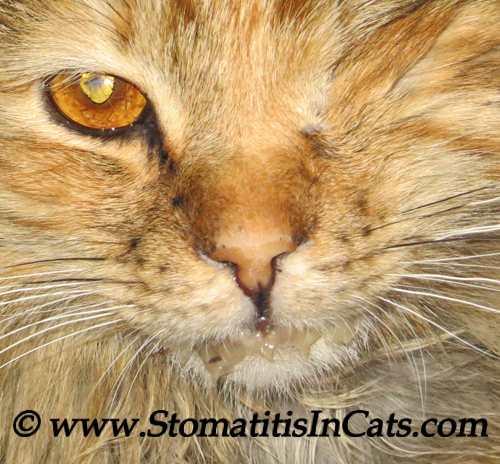







I have an FIV+ cat named Tar who was an outside feral cat that I tamed. He loves and trusts me so much; the second I sit down, plop, right on to my lap. He would live on my lap if he could. He has always been extremely healthy despite being FIV+. About 8 months ago, I noticed a really foul smell coming from his mouth and then he started drooling a little here and there. I took him to a very good feline vet and he checked his mouth thoroughly – no signs of any red or swollen gums. The only problem he noticed was an abscess. He gave me two bottles of Clavamox and told me to schedule the dental cleaning and scaling when the second bottle was almost done, which I did. The Clavamox took away all the signs of infection, the dental cleaning went well and no teeth needed to be extracted. In fact, the vet said that his teeth and mouth were in remarkable shape considering his FIV+ status. He was sent home on Baytril. About a month later, I noticed that horrible smell was back and some of the drooling. I looked in his mouth and saw some areas of red gums but nothing in his throat, tongue or upper palate. I took him to another vet who put him on plain amoxicillin. It cured the smell and the drooling. Two to three weeks later the smell was back so the vet put him on another round of amoxicillin, which also helped…for awhile. Tar went back again and the vet said he needed a stronger antibiotic so he gave him 10 days of Clindamycin. To back up a minute, when Tar first found me, he was limping but I couldn’t really see anything wrong with his paw or leg. I thought maybe he just jumped off of something a little too high and landed funny. Over the next few days, his foot began to swell and swell and swell. I compared it to looking like he was wearing a little boxing glove on his foot. I took him to a vet who gave him a shot of Convenia & a steroid. I also had him tested and I found out he was FIV+. It didn’t help and the foot continued to swell so much it tore open and he had an ulcer there. I took him back to a different vet at the same practice (and I can’t believe she is a very well-respected feline veterinary specialist) who told right off the bat without even examining him first, said, “well, if he’s FIV+, you might as well euthanize him.” I said absolutely NOT! At that time he was only about 8 months old and was truly the “happiest-go-lucky” cat I’ve ever met. I always say there’s a tiny little person in there zipped up in a cat suit. Anyway, I insisted on stronger antibiotics and she said Baytril was a good, broad-spectrum antibiotic I could try. She prescribed a 10-day course of that, plus buprinex and an anti-inflammatory medication. After 10 days, he was getting a little better so I asked for another 10 days. After 20 days, he was much improved but felt another 10 day course would finally kill off any remaining bacteria, which they gave me. So he was on Baytril for 30 days before it finally worked. His foot returned to normal and he was neutered a week later. Now fast forward to now, I told the new vet Tar may just need a 30 day course of clindamycin to kick the infection. I also mentioned I had been researching Tar’s symptoms and it all kept pointing back to Stomatitis and felt it might be an autoimmune response before I even started reading about it (I’m VERY in tune to my cats), and that the only viable treatment was total mouth extraction. The vet said, “oh yeah, it’s Stomatitis but he’s in the very early stages. He’s no where NEAR having the ulcers in the back of his teeth, throat, etc.” He prescribed a 30 day dose of clindamycin for him. Again, it worked for about a week but I knew the bacteria was becoming resistant to it. I know they say it’s a viral infection, but I do believe there is a secondary bacterial infection to Stomatitis as well. Tar never screamed in pain or even winced the slightest bit when eating and he still chases the girls around even thought they hate it. I can open his mouth to look inside and he doesn’t yelp in pain. His mouth and gums have never become swollen and there is no redness or “hamburger” look to the back of his teeth/throat. He still behaves as he always has; gulping down food, staying active, etc. I remembered from being on clindamycin myself for almost 4 month for my own periodontal/abscessed tooth that clindamycin can kill all the good bacteria in your digestive tract but so far Tar hasn’t had any diarrhea like he did on Baytril. But that got me thinking, the intestinal tract is mostly responsible for a healthy immune system so maybe he needs yogurt or a probiotic to provide that for him now, in addition to a grain free wet food diet? I’ve been reading about holistic approaches to this problem and tonight I bought him probiotic supplements, zinc, turmeric and Niacin (Inositol Hexancotinate) which will help attack whatever is attacking his gums. Plus I also bought several cans of grain free, one protein ingredient food. We’ll see how this works in about 2-3 weeks. Meanwhile, I contacted another vet for another opionion and he said on an FIV+ cat, you never want to put a cat through all that pain if the stomatitis will eventually come back. He recommended no pulling of the teeth and that he would need to be on prednisone indefinitely. I do not like this idea as it is merely putting a Band-Aid on the disease. Is there ANY type of anti-viral and anti-inflammatory medication in this first? Three different veterinarians have advised me to NOT have any of his teeth pulled. What should I do? I WANT the teeth extract and if the stomatitis return, I’ll dell with it then-with prednisone, etc. My got says to have them pulled. What do you think about this entire situation I just wrote about?
Lola,
Please accept my apology for the delay in a response.
Wow. You and Tar have been through a lot! It’s been a while since you wrote this so I’m hoping that you were able to find a vet who was helpful.
I don’t know anything about FIV since I’ve not had a cat with it, so I don’t know if there are any potential problems with either anesthetizing or pulling teeth on an FIV+ cat, so I’m afraid I can’t offer any advice regarding that aspect of your story.
However, my experience has taught me to deal with stomatitis early, before it gets to the point where the entire mouth and/or throat is inflamed. It sounds like you are of the same mind. As you know, I had great experience with the steroid cream, Lysine, and PlaqueOff, but these aren’t the only options. If you read through the comments on this site you’ll see a lot of suggestions from people who succeeded with other methods, such as colloidal silver and raw meat diets.
I wish you and Tar the best of luck finding a way to prevent the stomatitis from getting worse.
Rochelle
I have a feline leukemia care center and have had several cats develop stomatitus. It is an awful problem for them and the pain is intense. In addition to crying in pain when they eat their canned and or dry food, I have noticed some of them lick their mouth or work their tongue around, most likely because of pain. We can’t give our feline leukemia positive cats steroids as they are really hard on their already compromised immune systems. We use an immersion blender and add water to their canned food once a day and also feed chicken or turkey baby food (stage 1 foods) if we need to. Watching them in pain is the worst thing ever! I haven’t talked to our vet about teeth extractions, but plan to this week. FYI, we give our cats several supplements to help their immune systems such as DMG, Vitamin E, Prozyme, Organic Coconut Oil & Aloe. If you would like a list of specifics, please let me know. Thank you for your website and sharing your kitty’s story!
Sandy,
Thank you for sharing the supplements that you use. That is sure to be helpful to other people struggling to help their cats with this disease.
Rochelle
Thank you for getting back to me. I went on-line and found that zinc and l-lysine is good for mouth sores. I mash them up according to the amounts that is safe for cats along with acidophilus. She seems better and doesn’t cry out in pain and is eating pretty well. I also contact a vet that would do laser surgery treatment 5 for $100. which seems pretty reasonable . I spoke to a woman in Feb. that brought her cat there for teeth removal and he is quite caring for senior citizens and takes great care for the animals with a senior discount. I might have to travel 20 or 30 minutes to get there but I am sure it would be worth it to have her gums healed.
This is wonderful to hear!
I would like to invite you to share what you are doing on the forum here.
Rochelle
Hi,
I just got back fro the vets office with my Lila and diagnosed with stomatitis. They took blood from her to check for feline leukemia and hiv, and if she also had cat scratch fever which ha t be sent out. the first 2 results were negative the cat scratch fever will take 5 days. She also said they might have to take a biopsy which would cost $350. just for that and she might need steroids. Now I am really upset because in December 2014 I went to the same vet and told them that she cannot eat because she was in pain and drooling and her breath smelled. They got me to clean her teeth and pull 2 back teeth. I told them on her follow up that she was still in pain and not eating well they pushed it off as giver time. A month and 1/2 passes and I tell them that she cannot eat hard food or treats. I have to mash her wet food up and add water just so she can eat. Do you they some something in Dec. and they did not even mention Stomatitis I think they are just ringing up the $$$$ and I am retired and cannot afford all of this. I think they failed me in Dec. 2014 and now they what more money. Should I be leery of this. Help this is a stray that I took in on a winter night 2 years ago. She lived on the street and cried from house to house looking for someone to take her in and love her it is not fair for her to have to be put down. I might have to I might have to because of the unnecessary tests the vets office wants to do. Dou think all these tests are necessary? Or can I treat stomatitis with out the tests.
MaryAnne,
What a difficult situation you are in!
I do not know if the tests your vet is doing are necessary or not, so cannot speak to that. As for treating stomatitis, I don’t know that you need tests for that since stomatitis is usually diagnosed when other illnesses or diseases have been ruled out. To the best of my knowledge there is no way to test for stomatitis.
Have you considered getting a second opinion? If so, you might want to contact the cat rescue groups in your area, explain what is going on with Lila, and ask which vets they recommend.
Please let us know what happens.
Rochelle
I have added a forum to this site in an effort to make it easier for people to find and/or share information. I would like to invite you to take a look around and share what has worked for you (or what hasn’t), even if you’ve already shared it here. The forum will be a place where it is much easier to search for and find helpful information.
You can visit the forum here.
I will be posting this comment on all the pages of my site to make sure everyone who is subscribed to comments sees this, so I apologize if you get multiple copies of this message.
Rochelle,
I am taking a moment to update you on Bob’s progress. I will start off by saying that the transformation has been amazing. Bob has doubled in weight to 8 lbs. As you may recall, he was skeletal so this does not mean he’s overweight. His coat is shiny and sleek. He looks fantastic. He plays with my other two cats, something he hasn’t done for the past six years. He also grooms, another thing I haven’t seen much of in six years. He is now seven years old. There have been no further teeth extractions. His back teeth were pulled several years ago and I was pretty sure that the remainder would have to go this year, but so far it doesn’t look like that will be necessary any time soon. He is not at 100% all the time, but close to it most of the time.
Last August I did start him on the Prednisolone cream, administered in the ear once per day. My vet had not heard of this, but was willing to bring it in and try. Cost is kept down by purchasing in increments of three syringe fulls. In the morning and at night, I mix one scoop of Plaque Off and one scoop of Feline L-lysine into his meal, which is either one small can of Iams, usually the flaked tuna or mackerel, or whatever protein I am eating (poultry or fish as I eat almost no red meat) He has a good appetite and always eats the entire meal so he always gets the full dosage of PlaqueOff and L-lysine.
Bob remains diabetic and gets insulin shots twice a day. He also remains stable at a low dosage at 2 units. This is also why I keep him on a high protein diet and watch the fillers on dry cat food coming into the house. It is a little more expensive as I am feeding three cats, but probably healthier for all of them. The other two cats split a can of Friskies when Bob is eating his Iams.
Now for the not 100% statement. Occasionally the mouth odor and drooling resurface. This is followed by the bright red gums and swelling. All of this happens in one day; progression is fast, but now I know what to watch for. A round of antibiotics cures it. The vet and I rotate the type so that he doesn’t build up an immunity to the antibiotic. My vet is great and no longer sees Bob every time there is a need, which helps with cost. I will be doing that today, but the last purchase of antibiotics was in early December. I also use common sense and don’t start the antibiotics unless the symptoms are getting progressively worse. This is the longest stretch he has gone without needing antibiotics since starting the Prednisolone/Plaque-off/L-lysine treatment. The frequency of need has decreased each time so this is good. I am optimistic that the trend will continue.
I am feeling like Bob’s quality of life is excellent. Last year at this time I was accepting the fact that he didn’t have much longer, but I had done the best I could for him to give him a good life. The cortisone was no longer effective and that awful best-thing-for-him-get-him-out-of-pain decision was close. However, this is an amazing success story. Starting on insulin was helping, but the stomatitis part wasn’t going away. The cortisone gave him diabetes and was no longer fixing the mouth issues. I started using your findings with a “can’t hurt” philosophy. Talk about exceeding expectations!! Thank you, thank you, thank you, a million times!
Emma is six and just got diagnosed. They are pulling one of the worst teeth and we are starting a medicinal routine. I dont know what yet. I find out today when i pick her up. The vet seems to think it can be controled with a once a month med after this flare up clears. From what i have read here i am not so surd it will be that easy. Well the journey begins i guess. I dont want a life of pain for emma but i dont want to say goodbye yet.
Morgen,
Hopefully Emma has many good years still ahead of her. Please let us know how she does down the road.
Rochelle
Hi Rochelle, Thanks for the website. It is very helpful and good to know that my cat, Bob, and I are not alone. I have experienced a few things in addition to what you have, so I would like to share Bob’s story.
Bob is 6 years old. He is a shelter cat that came into my life at when he was 6-8 months old. He is a tabby that has remained very small. Right now he is six pounds and he has dropped down to 4 pounds when undergoing bad bouts.
It took about a year before he was diagnosed with stomatitis. He was exhibiting the drooling behavior you have described. I don’t remember when the odor started, but it was always a helpful sign to get him into the vet. He was also in pain and would run through the house trying to escape the pain. Eating slowed down as well. He started receiving cortisone/antibiotic shots. The first time he was good for a couple months, but frequency started increasing.
At about age 3, all of his back teeth were pulled. Initially it seemed to help a bit, but he was soon back on the cortisone. The shot would be good for 4-8 weeks. Other bad things started happening though. The steroid (cortisone) affected his skin. It became scaly and he would scratch a lot. I started giving him fish oil and another skin treatment, vitamin E based. I started L-lysine twice a day as well. I brushed him regularly to help out with the grooming as that slowed down as well. However, his skin was so thinned out that it would just open up, like a piece of cloth tearing. This happened about three times. Heartbreaking! I keep his back nails clipped, but that didn’t really help.
For the past year or so, the cortisone has been needed every three weeks and I keep doggie coats on him all the time. This looks silly on a cat, but he hasn’t ripped himself open. Also, the only way to get him to 3 weeks is to start oral antibiotics after two weeks. Another note, with the sore mouth giving him a pill isn’t kind. I got a few syringes without needles from my vet. I cut open capsules and pull oil into the syringe then squirt that into his mouth. I dissolve the feline lysine in water by measuring the amount of water, adding the powder, then doing the math to ensure a consistent dosage via syringe. In all honesty, I don’t know that the lysine is helping but I don’t want to run any risk of him getting worse if I stop it. I buy the big bottle too. It is inexpensive.
Three months ago he was looking as bad as he has ever been. He was down to 4 lbs. and his skin was terrible. My vet ran the tests and Bob was diagnosed as diabetic. Not having experience with diabetes, I didn’t catch the symptoms of rapid weight loss and increased water consumption. He is now on insulin twice a day (shots). He is looking great. Coat is healthy and grooming has resumed. He is now 6 lbs. and the dosage has stabilized. However, the mouth is no better. Within the next few weeks, the rest of his teeth will be pulled.
Bob has been incredibly expensive. Surgeries are costly. Homeopathic and prescription meds have been $50-$75 monthly. Now the insulin is $100 a bottle (the first bottle was good for 3 months; just started the second) and the syringes are about $25 per hundred. In addition, there are glucose checks every couple of weeks.
Obviously I love my Bob. He is such a sweet, gentle cat. Everyone loves Bob both at home and at the vet’s office. Even my other cats seem to understand that he needs special treatment. I will continue to invest in Bob unless it gets to the point that he has no quality of life. I will order the PlaqueOff today and ask my vet about the ear steroid. One article I read said that a vet was having success with bone therapy. Maybe PlaqueOff helps because of something related to this research? I appreciate any other suggestions.
Margie,
Wow! I almost don’t know where to begin with your story. It broke my heart to read about how thin the Cortisone made Bob’s skin and that he tore it open multiple times. I’ve never heard of that and can only image how awful it was to deal with. It was clever of you to put a coat on your cat to prevent further damage to his skin.
Bone therapy is something that I’ve not heard of before. If you haven’t already, this might be a good thing to discuss with your vet.
My understanding about PlaqueOff is that it helps by preventing plaque from forming in the mouth. It is believed that plaque triggers stomatitis, so having little to no plaque in the mouth can minimize the effects of stomatitis. I believe this to be true based on what I have seen in my cat Lily. Even though her teeth were removed, she still had plaque in her saliva and her mouth was still swollen and painful (as you can see in the pictures on my site where she has no teeth but still has inflammation). Whatever it does, it works wonderfully for Lily.
You might also ask your vet about changing food for your cat. I didn’t do this, but some people have had great success treating stomatitis by using specialized foods. I have never had a cat with diabetes so don’t know anything about it other than insulin treatments are needed, but I wonder if a change in diet may be helpful to both stomatitis and diabetes. It’s something else to ask your vet about.
Much luck to you and your cat as you battle this disease.
Rochelle
Hi Rochelle, thank you for a most informative website. I had to take my “Little” kittie to see our local vet for a dental. I had noted that she did not have much of an appetite, but then being small in stature – she is 5yrs old approximately, but looks rather like a cat of about 8 months old, I presumed tht she had a little appetite. She has not shown the symptoms you have mentioned, but does however, lick her lips very frequently and despite having had her teeth cleaned, still does this and seems to be in some discomfort. Is this possibly the start of a stomatitis? The vet mentioned stomatitis as a possibility when he did her dental, however I am not sure whether should take her in for a check up as an emergency or not. Can you advise, please.Many thanks.
Vanessa,
I have never heard of lick lipping to be a symptom of stomatitis. The only thing I’ve heard about lick lipping is that it can be a sign of an upset stomach. This would be a good question to ask your vet. You should be able to ask over the phone if you don’t want to take Little in to see your vet.
Rochelle
P.S. Lily is also a very small cat, and our nickname for her is Little Bit.
Oh my goodness, the drooling! Newman did the same thing, but much darker and more blood in it, all over my pillow. I actually made an appointment with MY doctor because I thought I was having nosebleeds in my sleep!
Wendy,
I understand why you would fear you were having nosebleeds in your sleep. Lily would sleep next to my head when she was drooling badly and left blood stains near my head. It would have been easy to mistake the blood as mine.
Rochelle
As the founder of a cat rescue, we find more than our share of stomatitis kitties; we get their teeth pulled but I am sad to say, the after effects for these cats isn’t that great. Our vet treats them with steroid shots but after awhile these don’t work either.
I’m trying to find information on after care, AFTER the teeth are pulled, now what? What supplementation will help them to maintain optimal health? What can we do to reduce the flare-ups that keep coming.
Can a cat develop plaque even though it doesn’t have teeth?
Candy,
I know that there are several ways to care for a cat after a tooth extraction, but I’m only familiar with what I do for Lily. Lily gets a twice-daily dose of Lysine and a once daily dose of both Prednisolone (a steroid) and PlaqueOff. Other people have had success with antiplaque water treatments such as AquaDent, but my cat Lily refused to drink the water that had this added to it.
Raw food diets have worked well for some cats, but I have no experience at all with this and don’t know what to advice with this type of diet. Others have used foods made from specialty meats like duck or rabbit, but they are too expensive for us to use.
As for plaque in a tooth-free mouth, I don’t honestly know the answer to that. Thinking logically, it would seem that the answer is no because there are no teeth for it to form on. But, PlaqueOff has been a life-saver for Lily, so I think it is possible. PlaqueOff is meant to prevent plaque from forming on teeth, and is not intended for stomatitis treatment, but Lily has had great success with it.
Another thing to consider is minimizing stress. Stress seems to be a trigger for stomatitis kitties. This is probably hard to control in a cat rescue situation, but keeping them as stress-free as possible is going to help.
Rochelle
My 8yr old male cat was just diagnosed with stomatitis and is scheduled to have his back teeth extracted next week. I have several concerns because the only symptom he has shown is that it is painful for him to eat. No drooling and no bad breath. Do you think I am doing the right thing having the surgery?
It is impossible for me to know if a tooth extraction is right for your kitty. Drooling and bad breath are symptoms of very advanced stomatitis, so it sounds like your cat’s stomatitis has been caught early. There may also be other symptoms that you don’t see. In the case of my cat, Lily has swelling and redness in the back of her throat. Your cat might also have this, which would have been seen by your vet.
A tooth extraction is a major surgery, and very expensive. If you are unsure if this is the best thing for your cat, it never hurts to get a second opinion. If you don’t know where to go for one I recommend contacting a local cat rescue group and asking who they trust for dental work on cats. They know all the vets, and know who is good and who is not. That’s what I did and is how I found my current vet.